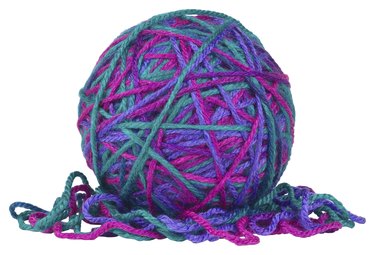Things You'll Need
Bulky yarn or two colors of thinner yarn
Scissors
Tapestry needle

Finger knitting is a basic yarn work technique that even children and crafts novices can learn easily. Rather than knitting on needles, you manipulate the yarn around the fingers of one hand. Though the finished knitted strip can be as long as you want, it will always only be as wide as your palm, four stitches across. However, you can use a tapestry needle to sew multiple finger-knitted pieces together to create other items, such as socks.
Step 1
Cast on a single strand of bulky yarn or two strands of thinner yarn. Place the tail of the yarn between your thumb and index finger, palm up, and wrap the yarn over your index finger, under your middle finger, over your ring finger and under your pinky. Go around your pinky and return back toward the thumb, going over the pinky, under the ring finger, over the middle finger and under the index finger.
Video of the Day
Step 2
Repeat the entire pattern, weaving toward the pinky and back to the index finger as in Step 1. Each finger should now have two loops on the palm side.
Step 3
Lift the lower loop on the pinky up and over the upper loop and off the finger, so that it sits to the back of your hand. Repeat with the ring finger, middle finger and index finger.
Step 4
Weave the loose end of the yarn over the index finger, under the middle finger, over the ring finger, under the pinky and back again, as in Step 1. Then, repeat Step 3 to lift the lower loops on each finger over the upper loops and to the back of the hand.
Step 5
Continue these two steps until the knitted piece on the back of your hand is your desired length. For a very basic sock pattern, you might knit one piece the length from your toe-tips to your ankle joint, a second piece the length from your toe-tips along the bottom of your foot, around the heel and up to the ankle, and a third piece to wrap around your ankle as a cuff.
Step 6
Bind off when each finger only has one loop on it. Lift the loop on the pinky finger off and place it on the ring finger. Lift the bottom loop on the ring finger up and over the top loop and off to the back of the hand. Lift the remaining ring finger loop off and onto the middle finger, and repeat the bind off. When you have only one index finger loop remaining, run the tail of the thread through that loop and pull tight.
Step 7
Assemble your basic sock by resting the top-of-the-foot piece on top of the bottom-of-the-foot piece, right sides together. Use a tapestry needle and a piece of the same thread with which you were knitting to sew the toe seam. Then, sew along the two sides of the sock. Remember that the bottom piece is longer than the top piece; don't try to stretch the top piece to be even.
Step 8
Turn the cuff piece on its side and stitch it to the top of the top piece, and then to the side stitches and back of the bottom piece, so that the sock takes shape. Finger knitting tends to be loose and flexible, so you can adjust the shape of the sock as you sew.
Step 9
Weave in the loose yarn ends and flip the sock right side out to wear it. Repeat the entire process to make a second sock.
Tip
If you’re right-handed, hold the knitting on your left hand, and vice versa. If you want to take a break during the finger knitting process, slide the loops off your fingers and onto a knitting needle, crochet hook or ink pen. Larger feet may require you to sew together two finger-knit pieces side by side on the bottom and top of the foot. If in doubt, hold your finger knitting up to the foot as a gauge.
Video of the Day